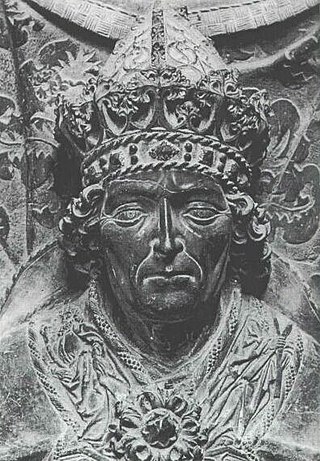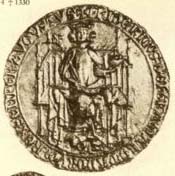Sources
Bohemond of Warnesberg Born: unknown Died: 9 December 1299 in Trier | ||
| Catholic Church titles | ||
|---|---|---|
| Regnal titles | ||
| Preceded by | Archbishop- Elector of Trier as Bohemond I 1286–1299 | Succeeded by |
| International | |
|---|---|
| National | |
| People | |
Bohemond I | |
|---|---|
| Archbishop of Trier | |
| Church | Catholic Church |
| Diocese | Archdiocese of Trier |
| In office | 1286–1299 |
| Personal details | |
| Died | 9 December 1299 |
Bohemond of Warnesberg (died 9 December 1299) was the Archbishop of Trier (as Bohemond I) and a Prince Elector of the Holy Roman Empire from 1286 to his death.
He achieved high religious postings in both Trier and Metz before being selected to replace Henry of Finstingen as archbishop in the former. Chosen by Pope Nicholas IV, he did not receive his confirmation in Rome until 6 March 1289, after three years during which two of his competitors had died and the third, Gerard II of Eppstein had been received the mitre in Mainz.
He was a man of letters and a knight, concerned for both the spiritual and saecular health of his underlings. He had a high reputation with his fellow princes, but was unable to impose his will on those of his cathedral chapter who opposed him. When the pope appointed Peter von Aspelt and Johannes Gylet cathedral canons, Bohemond opposed them because they were not locals. Even a papal interdict did not cause him to relent.
When King Rudolf I of Germany desired to make his son Albert crowned in his lifetime to ensure his succession, Bohemond readily crowned him. On Rudolf's death in 1291, however, Siegfried of Cologne and the aforementioned Gerard of Mainz forced him to change his vote and elect Adolf of Nassau as king. After Adolf's coronation, Bohemond remained faithful to him and negotiated for him in Flanders between the English and the French. He prepared an army to fight against Albert, but on hearing the news of Adolf's death at the Battle of Göllheim, he transferred his allegiance to Albert. He received gifts of property from Philip IV of France, Edward I of England, and, most importantly, Albert himself, who gave him the castle of Cochem, originally pawned by Adolf to be a hereditary possession of the church of Trier. Bohemond died in Trier and was buried in the monastery of Himmerode, which he particularly loved.

Albert I of Habsburg was a Duke of Austria and Styria from 1282 and King of Germany from 1298 until his assassination. He was the eldest son of King Rudolf I of Germany and his first wife Gertrude of Hohenberg. Sometimes referred to as 'Albert the One-eyed' because of a battle injury that left him with a hollow eye socket and a permanent snarl.

Louis IV, called the Bavarian, was King of the Romans from 1314, King of Italy from 1327, and Holy Roman Emperor from 1328 until his death in 1347.

Rudolf I was the first King of Germany from the House of Habsburg. The first of the count-kings of Germany, he reigned from 1273 until his death.

Adolf was the count of Nassau from about 1276 and the elected king of Germany from 1292 until his deposition by the prince-electors in 1298. He was never crowned by the pope, which would have secured him the imperial title. He was the first physically and mentally healthy ruler of the Holy Roman Empire ever to be deposed without a papal excommunication. Adolf died shortly afterwards in the Battle of Göllheim fighting against his successor Albert of Habsburg.

The Archbishopric of Magdeburg was a Latin Catholic archdiocese (969–1552) and Prince-Archbishopric (1180–1680) of the Holy Roman Empire centered on the city of Magdeburg on the Elbe River.

Frederick the Fair or the Handsome, from the House of Habsburg, was the duke of Austria and Styria from 1308 as well as the anti-king of Germany from 1314 until 1325 and then co-king until his death.
Adolf of Altena, Adolf of Berg or Adolf of Cologne, was Archbishop of Cologne from 1193 to 1205.
Christian I (c. 1130 – 23 August 1183), sometimes Christian von Buch, was a German prelate and nobleman. He was Archbishop of Mainz and Archchancellor of Germany from 1165 until his death in 1183. He was originally elected archbishop in 1160 in a disputed election. He served the Emperor Frederick I as a diplomat in Italy on two occasions.
Conrad of Wittelsbach was the Archbishop of Mainz and Archchancellor of Germany from 20 June 1161 to 1165 and again from 1183 to his death. He was also a cardinal of the Roman Catholic Church.
Bohemond of Saarbrücken was the Archbishop of Trier and a Prince Elector of the Holy Roman Empire from 2 May 1354 to 4 April 1362.

Herman(n) of Salm, also known as Herman(n) of Luxembourg, the progenitor of the House of Salm, was Count of Salm and elected German anti-king from 1081 until his death.

Peter of Aspelt was Archbishop of Mainz from 1306 to 1320, and an influential political figure of the period. He brought the archbishopric to its peak of power.

Rudolf I, a member of the House of Ascania, was Duke of Saxe-Wittenberg from 1298 until his death. By the Golden Bull of 1356 he was acknowledged as Elector of Saxony.

Theoderich von Wied was Archbishop and Prince-elector of Trier from 1212 until his death.
The German throne dispute or German throne controversy was a political conflict in the Holy Roman Empire from 1198 to 1215. This dispute between the House of Hohenstaufen and House of Welf was over the successor to Emperor Henry VI who had just died. After a conflict lasting 17 years the Hohenstaufen Frederick II prevailed.

The imperial election of 1273 was an imperial election held to select the emperor of the Holy Roman Empire. It took place in Frankfurt on October 1.
The imperial election of 1292 was an imperial election held to select the emperor of the Holy Roman Empire. It took place in Frankfurt on May 5. Emperor Rudolf I of Germany had died on 15 July 1291.
Diether of Nassau, German: Diether von Nassau was a clergyman from the Walramian branch of the House of Nassau. From 1300 to 1307 he was Archbishop and Elector of Trier as Diether III.

Arnold II of Isenburg was Archbishop of Trier from 1242 to his death. A long-time member of the cathedral chapter in Trier, he held several provostships before being elected as archbishop, succeeding his uncle Theoderich von Wied. The election was controversial, and king Conrad IV of Germany granted the regalia to Rudolf de Ponte, the opposing candidate, instead. Arnold was confirmed as archbishop by Pope Innocent IV and consecrated in 1245.

Adolf I von Nassau was Bishop of Speyer 1371–1388 and Archbishop of Mainz 1381–1390.